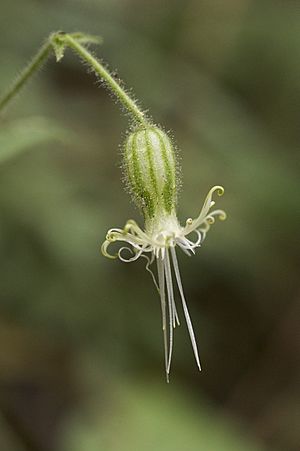Lemmon's catchfly facts for kids
Quick facts for kids Lemmon's catchfly |
|
|---|---|
 |
|
| Scientific classification | |
| Genus: |
Silene
|
| Species: |
lemmonii
|
| Synonyms | |
|
Silene palmeri |
|
Lemmon's catchfly (Silene lemmonii) is a pretty flowering plant. It belongs to the Caryophyllaceae family, also known as the pink family. You can find this plant growing in the mountains of Oregon and California. It likes to live in forests and woodlands, especially in places that are a bit damp.
Description
Silene lemmonii is a type of plant that lives for many years. We call this a perennial herb. It grows several stems and shoots from a tough, woody base. This base is called a caudex.
The stems can grow up to 45 centimeters (about 18 inches) long. Some stems lie on the ground (decumbent), while others stand straight up (erect). The stems are covered in tiny hairs. The hairs near the top of the plant are sticky, like tiny glands.
Most of the leaves grow low on the plant. They are shaped like an oval or a spear tip. These leaves are usually a few centimeters long. Smaller leaves might also grow higher up on the stems.
Flowers
The plant produces 1 to 7 flowers in a cluster. This cluster is called an inflorescence. The flowers hang downwards and grow on sticky stalks. Moths help to pollinate these flowers.
Each flower has a tube-shaped or puffy outer layer. This layer is made of five sepals that are joined together. This outer layer is called the calyx. It opens at the top to show five petals inside.
The petals can be whitish, yellowish, or pinkish. Their tips are deeply split into four thin, sometimes hair-like parts. These parts might curl or get tangled. Long stamens stick out from the flower's opening. Even longer, whisker-like styles (part of the gynoecium) stick out even farther.

